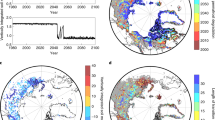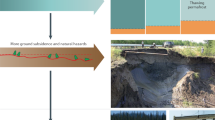Abstract
This is an attempt to predict the potential economic impacts on public infrastructure upon degrading permafrost which is losing its bearing capacity. Climate change-related increases in costs (economic losses or damage) are estimated for several climate futures by 2050 separately for 39 municipalities located in the Russian Arctic permafrost domain. The hypothetical changes in mean annual ground temperature are inferred from air and ground temperature trends and monitoring data, with reference to forecasts of the Climate Center of the Russian Meteorological Service (Roshydromet) and climate change scenarios (representative concentration pathways RCP2.6, RCP4.5, and RCP8.5). The calculations were performed for twelve possible cases with different air ground temperature assumptions, with regard to the difference between the ground and air mean annual temperatures. This difference, or temperature shifts, due to radiation, snow, vegetation, and atmospheric precipitation effects, was estimated either by means of calculations proceeding from possible changes of climate variables or by summation of known values reported from different Arctic areas. The economic losses were evaluated as maximum and minimum values at extreme values of permafrost parameters, separately for each case. The buildings and facilities on permafrost were assumed to have pile foundations with friction piles. The permafrost thaw impact was meant as the loss of the soil capacity to bear the support structures for the infrastructure leading to deformation and failure. The impact was considered significant if the change exceeded the safety margin according to the Russian Building Code. The greatest damage is expected to housing stock and buildings and structures of main economic sectors. The monetary value of the residential infrastructure was estimated using a specially compiled inventory database including address, age, and surface area of 23.900 houses in 39 selected Russian Arctic municipalities over a total area of 44.600 km2. The estimation of fixed assets stemmed from the assumption that their monetary value is proportional to the gross output in the respective economic sector, which, in its turn, correlates with the payroll total corrected for mean industry coefficients for different regions of Russia. The potential damage may reach up to US$ 132 billion (total) and ~ US$ 15 billion for residential infrastructure alone, which generally agrees with other estimates.





Similar content being viewed by others
Notes
The costs were originally calculated in Russian roubles in the prices of 2020 and then converted to US dollars at an US$/RUB exchange rate of 72.55, which is a mean annual value for 2020 as reported by the Russian Central Bank.
Decree N 459 of 22.08.2012 Methodological Guidelines for Real Estate Valuation, According to the National Economic Accounting System, by the Federal State Statistic Service.
Russian Ruble and US Dollar conversion bases on the average annual data of the Central Bank of Russia exchange rate for 12 months of 2020 (1 US dollar—72.55 rubles).
References
Badina SV (2020a) Prediction of socioeconomic risks in the cryolithic zone of the Russian Arctic in the context of upcoming climate changes. Stud Russ Econ Dev 31:396–403. https://doi.org/10.1134/S1075700720040036
Badina SV (2020b) The diversity of Russia’s Arctic cities. Rus Anal Digest 256(7–9):1. https://doi.org/10.3929/ethz-b-000440622
Badina SV (2021) Estimation of the value of buildings and structures in the context of permafrost degradation: the case of the Russian Arctic. Polar Sci. https://doi.org/10.1016/j.polar.2021.100730
Berdnikov NM, Malkova GV, Drozdov DS, Korostelev YV, Gravis AG, Ponomareva OE (2020) Forecast map of the temperature of permafrost rocks in the cryolithozone of Russia. In: "Sustainability of natural and technical systems in cryolithozone" conference proceedings. IMZ, Yakutsk. pp. 63–65 (in Russian)
Biskaborn BK et al (2019) Permafrost is warming at a global scale. Nat Commun 10:264. https://doi.org/10.1038/s41467-018-08240-4
Burke M, Hsiang SM, Miguel E (2015) Global non-linear effect of temperature on economic production. Nature 527:235. https://doi.org/10.1038/nature15725
Construction Rules (2012a) Foundations and permafrost foundations. Working Document SP 25.13330.2012 http://docs.cntd.ru/document/1200095519 (in Russian)
Construction Rules (2016) Basements and Foundations of Buildings and Structures. Working Document SP 22.13330.2016 http://docs.cntd.ru/document/456054206 (in Russian)
Climate Change in the CIS Countries in the 21st Century http://seakc.meteoinfo.ru/research/34-change-climat21/130-change (in Russian)
Ershov ED (ed) (1991) Geocryological Map of the USSR. Nedra, Moscow (in Russian)
Ershov ED (2004) General geocryology. Cambridge University Press, Cambridge
Ershov ED et al (eds) (1988) Geocryology of the USSR. Nedra, Moscow (in Russian)
Esau I, Miles V, Varentsov M, Konstantinov P, Melnikov V (2019) Spatial structure and temporal variability of a surface urban heat island in cold continental climate. Theoret Appl Climatol 137(3–4):2513–2528. https://doi.org/10.1007/s00704-018-02754-z
Euskirchen E, Goodstein E, Huntington H (2013) An estimated cost of lost climate regulation services caused by thawing of the Arctic cryosphere. Ecol Appl 23:1869–1880. https://doi.org/10.1890/11-0858.1
Harris S, Brouchkov A, Cheng G (2018) Geocryology: characteristics and use of frozen ground and permafrost landforms. CRC Press, London. https://doi.org/10.4324/9781315166988
Henriques ST, Borowiecki KJ (2014) The drivers of long-run CO2 emissions: a global perspective since 1800. Discussion Papers on Business and Economics, University of Southern Denmark, 13/2014 https://doi.org/10.2139/ssrn.2486501
Hjort J, Karjalainen O, Aalto J et al (2018) Degrading permafrost puts Arctic infrastructure at risk by mid-century. Nat Commun 9:5147. https://doi.org/10.1038/s41467-018-07557-4
Hope C, Schaefer K (2016) Economic impacts of carbon dioxide and methane released from thawing permafrost. Nat Clim Chang 6:56–59. https://doi.org/10.1038/nclimate2807
IPCC (2014) Climate change 2014: synthesis report. contribution of working groups I, II and III to the fifth assessment report of the intergovernmental panel on climate change. In: Core Writing Team, Pachauri RK and Meyer LA (eds) IPCC, Geneva, Switzerland
Kaurkin VD (2005) Projected thermal regime of permafrost and stability of geotechnical systems in sakha republic (Yakutia) under climatic change. Candidate Dissertation (Geology & Mineralogy), Moscow University, Moscow (in Russian)
Khrustalev LN, Parmuzin SY, Emelyanova LV (2011) Stability of northern infrastructure under changing climate. Universitetskaya Kniga, Moscow (in Russian)
Kudryavtsev VA, Melamed VG, Garagula LS et al (2016) Fundamentals of frost forecasting in geotechnical research. Moscow University, Moscow (in Russian)
Kudryavtsev VA, Garagulya LS, Melamed V (1977) Fundamentals of frost forecasting in geological engineering investigations, Nauka, Moscow. Draft Translation 606. CRREL, Hannover, NH. pp 489
Land Territories of the Russian Arctic Domain. Decree No. 296 of the President of the Russian Federation of 02.05.2014. http://www.kremlin.ru/acts/bank/38377 (in Russian)
Leksin VN, Porfiriev BN (2019) The Russian Arctic: the logic and paradoxes of change. Stud Russ Econ Dev 30:594–605 (in Russian)
Malkova GV, Drozdov DS, Gravis AG et al (2021) Spatial and temporal variability of permafrost in the western sector of the Russian Arctic: results of complex monitoring at geocryological sites. In: “Contemporary research on cryosphere transformation and issues of geotechnical safety of structures in the Arctic” conference proceedings. Salekhard (in Russian)
McKenzie JM, Kurylyk BL, Walvoord MA et al (2021) Invited perspective: what lies beneath a changing Arctic? Cryosphere 15:479–484. https://doi.org/10.5194/tc-15-479-2021
Melnikov VP, Drozdov DS (2006) Distribution of permafrost in Russia. Advances in the geological storage of carbon dioxide: International approaches to reduce anthropogenic greenhouse gas emissions. Kluwer Academic Publishers, NATO Science Series IV: Earth and Environmental Sciences, Vol. 65. New York, Boston, Dordrecht, London, Moscow. pp. 69–80
Melvin AM, Larsen P, Boehlert B, Neumann JE, Chinowsky P et al (2017) Climate change damages to Alaska public infrastructure and the economics of proactive adaptation. PNAS 114:E122–E131. https://doi.org/10.1073/pnas.1611056113
Kasimov NS (ed.) (2017) National Atlas of the Arctic. Roskartografiya, Moscow (in Russian)
Pavlov AV, Malkova GV (2009) Small-scale mapping of trends of the contemporary ground temperature changes in the Russian North. Earth’s Cryosphere 13:32–39 (in Russian)
Porfiriev BN, Eliseev DO, Streletskiy DA (2019) Potential economic impact of climate-driven permafrost degradation on road infrastructure in the Russian Arctic. Bull Rus Acad Sci 89:1228–1239 (in Russian)
Romanovsky V, Osterkamp T (1997) Thawing of the active layer on the coastal plain of the Alaskan Arctic. Permafr Periglac Process 8:1–22
Romanovsky VE et al (2010) Thermal state of permafrost in Russia. Permafr Periglac Proc 21:136–155
Roshydromet (2014) Second roshydromet assessment report on climate change and its consequences in the Russian federation, Moscow https://cc.voeikovmgo.ru/images/dokumenty/2016/od2/resume_ob_eng.pdf (in Russian)
Roshydromet (2018) Climate in the Russian federation in 2018. Rosgidromet Report. http://global-climate-change.ru/index.php/ru/component/content/article/2189-doklad (in Russian)
Roshydromet (2021) Scenario forecasts based on global models. https://cc.voeikovmgo.ru/ru/klimat/izmenenie-klimata-rossii-v-21-veke (in Russian)
Russia entered the top three leaders of CO2 emissions (06.10.2021) https://aftershock.news/?q=node/1021019&full (in Russian)
Sazonova TS, Romanovsky VE (2003) A model for regional-scale estimation of temporal and spatial variability of active layer thickness and mean annual ground temperatures. Permafr Periglac Process 14:125–139. https://doi.org/10.1002/ppp.449
Streletskaya ID, Leibman MO (1995) Russian permafrost map index. Workshop on Permafrost Data Rescue in Access. World data center for glaciology, Glaciological data report GD-28, pp. 33–144
Streletskiy DA, Shiklomanov NI, Nelson FE (2012) Permafrost, infrastructure and climate change: a GIS-based landscape approach to geotechnical modeling. Arct Antarct Alp Res 44:368–380. https://doi.org/10.1657/1938-4246-44.3.368
Streletskiy DA et al (2015) Changes in the 1963–2013 shallow ground thermal regime in Russian permafrost regions. Environ Res Lett 10:125005
Streletskiy D, Suter L, Shiklomanov N, Porfiriev BN, Eliseev DO (2019) Assessment of climate change impacts on buildings, structures and infrastructure in the Russian regions on permafrost. Environ Res Lett 14(2):025003
Suter L, Streletskiy D, Shiklomanov N (2019) Assessment of the cost of climate change impacts on critical infrastructure in the circumpolar Arctic. Polar Geogr 42:267–286. https://doi.org/10.1080/1088937X.2019.1686082
Technical Guide: Design and construction considerations for foundations in permafrost regions (2019) CSA PLUS 4011.1:19. CSA Group. Canadian Standards Association
Tian Z, Ren T, Heitman JL, Horton R (2020) Estimating thermal conductivity of frozen soils from air-filled porosity. Soil Sci Soc Am J 84:1650–1657. https://doi.org/10.1002/saj2.20102
Timofeev PA (2016) Assessment of hydrometeorological safety of the Russian Arctic from fuzzy information: theoretical and methodological background. Candidate Dissertation. N.E. Zhukovsky and Yu.A. Gagarin Air Force Aacademy, Voronezh (in Russian)
Varlamov SP, Skachkov YB, Skryabin PN (2019) Evolution of the thermal state of permafrost under climate warming in Central Yakutia. Holocene 29:1401–1410
Wang K, Jafarov E, Overeem I (2020) Sensitivity evaluation of the Kudryavtsev permafrost model. Sci Total Environ V 720:137538
Yin G, Niu F, Lin Z et al (2016) Performance comparison of permafrost models in Wudaoliang Basin, Qinghai-Tibet Plateau China. J Mt Sci 13:1162–1173
Yumashev D, Hope C, Schaefer K et al (2019) Climate policy implications of nonlinear decline of Arctic land permafrost and other cryosphere elements. Nat Commun 10:1900. https://doi.org/10.1038/s41467-019-09863-x
Zhang T (2005) Influence of the seasonal snow cover on the ground thermal regime: an overview. Rev Geophys 43:RG4002
Zukerman VA, Goryachevskaya ES (2016) Innovative economic development of the Russian Arctic: problems and prospects. In: Russia: development trends and prospects, institute of scientific information on social sciences, Russian academy of sciences, Moscow (in Russian)
Funding
No funding was received.
Author information
Authors and Affiliations
Corresponding author
Ethics declarations
Conflict of interest
The authors declare no conflicts of interests.
Additional information
Publisher's Note
Springer Nature remains neutral with regard to jurisdictional claims in published maps and institutional affiliations.
Rights and permissions
About this article
Cite this article
Melnikov, V.P., Osipov, V.I., Brouchkov, A.V. et al. Climate warming and permafrost thaw in the Russian Arctic: potential economic impacts on public infrastructure by 2050. Nat Hazards 112, 231–251 (2022). https://doi.org/10.1007/s11069-021-05179-6
Received:
Accepted:
Published:
Issue Date:
DOI: https://doi.org/10.1007/s11069-021-05179-6




